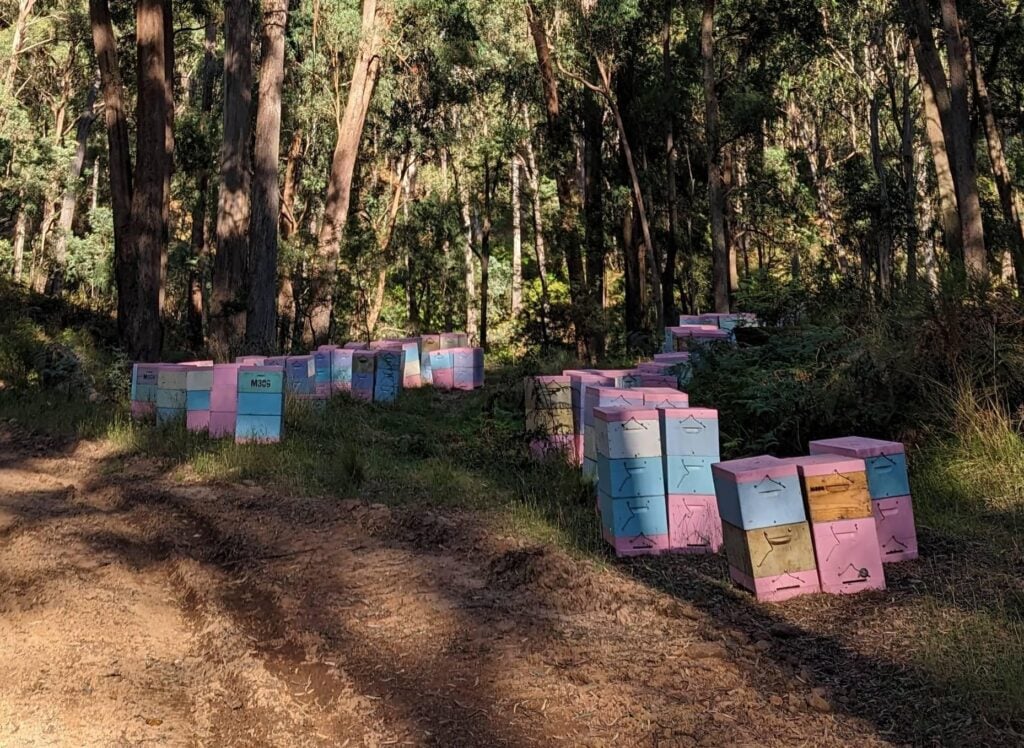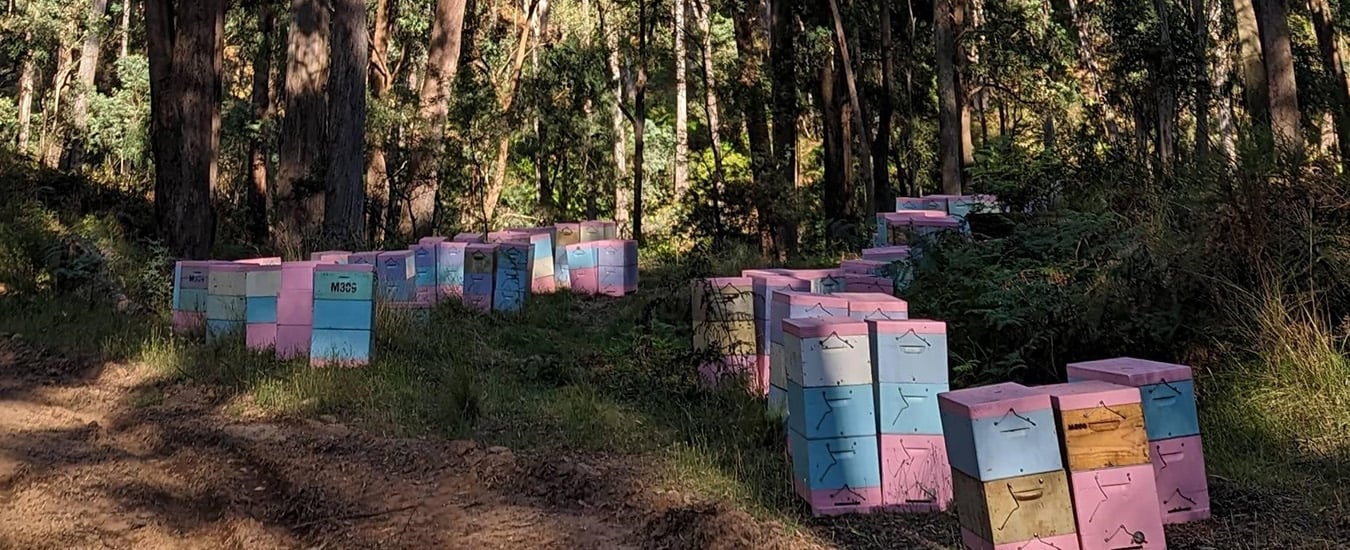While we are hoping for a successful eradication of Varroa in New South Wales, beekeepers should prepare for the possibility of living with the pest. By following some simple biosecurity procedures, beekeepers can prevent or delay Varroa from infesting their apiaries.
How does Varroa spread?
To understand what biosecurity measures are required to limit the spread of Varroa, we must first understand how Varroa spreads in the first place (Figure 1).

Figure 1. How Varroa spreads within and between apiaries. The yellow hive is the first hive to be infested with Varroa. Varroa spreads to other hives in the apiary via bee drift or the beekeeper moving infested frames of bees to other colonies (orange arrows). The yellow colony is weak and dying. Bees from a colony in another apiary rob it out (red arrow), bringing Varroa back to their apiary with them, where it begins to spread. One of the colonies in the first apiary swarms or absconds (blue arrow), with the colony taking up residence in an abandoned hive in another apiary. Varroa has now broken out of the foraging range of the first apiary (black circle).
Varroa spreads primarily via horizontal transmission, which occurs when healthy colonies acquire mites from infested colonies nearby. This usually occurs in one of the following ways:
- Drifting: a worker or drone carrying a mite leaves their hive and enters a different hive, introducing Varroa into it.
- Robbing: a worker enters a weak or collapsing hive to steal honey or pollen, acquires a mite while inside, and then returns to her own hive with the mite attached. Robbing has been shown to be a highly significant factor in the spread of Varroa between neighbouring hives (Peck and Seeley, 2019). As highly Varroa-infested colonies are more likely to be weak or collapsing, they are perceived as easy targets by robber bees. But any resources they are able to take from them come with a high price – infestation by Varroa.
- Absconding: if colonies have a high mite load, the irritation caused by the mites to adult bees may induce them to abandon their hive, or abscond. Absconded colonies can travel up to 15 km to escape the source of irritation. But in the case of Varroa, the mites attached to the bees will be brought with them, becoming an infestation risk to colonies in the area.
- Human interference: if a beekeeper is unaware that one of their hives is carrying Varroa and then swaps frames from this colony into a new colony, or moves the infected colony to a different apiary, they can unwittingly spread Varroa to more of their hives and apiary sites.
Varroa can also spread via vertical transmission, which occurs when a parent passes a disease to their offspring. In the case of Varroa and honey bees, this happens during reproductive swarming. When a colony splits to form a reproductive swarm, approximately 25% of all the Varroa mites within it travel with the swarm to its new nest site (Wilde et al., 2005). If the swarming colony has little sealed brood, then an even higher percentage of the mites will leave with the swarm as there will be more mites living on the adult bees rather than in the brood comb (Wilde et al., 2005).
Reproductive swarms can establish new colonies several kilometres away from the parent colony. As with absconded colonies, if the swarm is carrying Varroa mites, it becomes a danger to the existing colonies in the area as horizontal transmission of Varroa to them is now possible.
So what can we do about it?
Fortunately, there are some simple practices beekeepers can employ to reduce the spread of Varroa between colonies and apiaries.
The simplest is distance. The further apart colonies are kept, the less likely bees are to drift between them. Research has shown that colonies kept 100 m apart had significantly lower Varroa infestation rates than those kept 10 m apart (Nolan and Delaplane, 2016).
Of course, keeping hives hundreds of metres apart is not feasible for most beekeepers. However, steps can still be taken to reduce drift of bees, and in turn, spread of Varroa. Beekeepers can paint the front of their hive boxes with different colour combinations or patterns to reduce orientation errors and minimise drift of workers and drones between colonies (Figure 2). Additionally, beekeepers should ensure their colonies are strong and well-fed, and the box is in good condition to reduce robbing behaviour. And finally, beekeepers should practice swarm management – if Varroa is detected within a hive, steps should be taken to ensure this hive does not swarm and potentially bring the mite to new areas.

Figure 2. Hive boxes painted with different colour combinations to help bees return to the correct hive. This can help reduce the spread of Varroa and other diseases via drift. (Photo: Michael Holmes)
Checking your infestation levels at regular intervals (via alcohol wash or brood uncapping) will allow you to treat, manage or remove any heavily infested colonies before they collapse and send Varroa looking for a new home. It will also prevent Varroa spread by beekeeper error, as the beekeeper will know to isolate infected hives and not to introduce any of their brood comb to other hives under their care. This should help keep your apiary level infestation low.
Good Varroa management will depend largely on personal responsibility. While the above steps will not completely eliminate transmission of Varroa, they will slow its spread through an individual beekeeper’s hives and apiaries. This will give beekeepers a much better chance to effectively suppress any outbreaks of Varroa within their hives and apiaries, and also make it less likely that any Varroa they may have will spread to other apiaries or to the feral population.
References:
- Nolan and Delaplane (2016) Distance between honey bee Apis mellifera colonies regulates populations of Varroa destructor at a landscape scale, Apidologie 48: 1–9.
- Peck and Seeley (2019) Mite bombs or robber lures? The roles of drifting and robbing in Varroa destructor transmission from collapsing honey bee colonies to their neighbors, PLoS One 14: e0218392.
- Wilde, Fuchs, Bratkowski and Siuda (2005) Distribution of Varroa destructor between swarms and colonies, Journal of Apicultural Research 44: 190–194.
Acknowledgements:
- Resilient beekeeping in the face of Varroa. AgriFutures Australia. Nadine Chapman, Emily Remnant, Michael Holmes (University of Sydney), Jody Gerdts (Bee Scientifics, La Trobe University), John Roberts (CSIRO), Julia Grassl (University of Western Australia) and Sasha Mikheyev (Australian National University)
- This article was peer-reviewed by Emily Remnant and Nadine Chapman.


